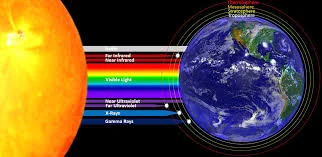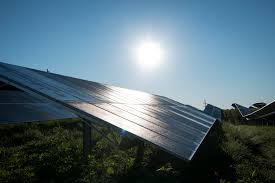The term solar ultra violet radiation is define as the energy emitted by the sun in the in the form of electromagnetic waves. The UV-R, name given to the electromagnetic spectrum band between 100 and 400 nm wavelengths (1 nm = 1 nanometer = 10-9 m), corresponds to less than 10% of the total solar radiation incident on the top of atmosphere.
This small spectral radiation band is subdivided, according to recommendation of the International Commission on Illumination (Commission Internationale de l’Éclairage – CIE), into: UVC, between 100 and 280 nm; UVB, between 280 and 315 nm; and UVA, between 315 and 400 nm.
The remaining over 90% of solar radiation practically corresponds to the visible spectrum (400-780 nm) and near infrared spectrum (780-4000 nm).
UV-R undergoes intense attenuation when interacting with atmospheric components along the way to the Earth’s surface.
As we will see further on, this attenuation depends on the type of incident radiation, which is more intense for the shorter wavelengths.
Despite the small radiation amount in the UV spectral range, such fluxes are responsible for several important photo-biological and photochemical effects.
1. Effect on human and Animal Health
Increased penetration of solar UV-B radiation is likely to have profound impact on human health with potential risks of eye diseases, skin cancer and infectious diseases. UV radiation is known to damage the cornea and lens of the eye.
Chronic exposure to UV-B could lead to cataract of the cortical and posterior sub capsular forms. UV-B radiation can adversely affect the immune system causing a number of infectious diseases.
In light skinned human populations, it is likely to develop no melanoma skin cancer (NMSC). Experiments on animals show that UV exposure decreases the immune response to skin cancers, infectious agents and other antigens.
2. Effects on Aquatic organisms
While more than 30 percent of the world‘s animal protein for human consumption comes from the sea alone, it is feared that increased levels of UV exposure can have adverse impacts on the productivity of aquatic systems.
High levels of exposure in tropics and subtropics may affect the distribution of phytoplanktons which form the foundation of aquatic food webs.
Reportedly a recent study has indicated 6-12 percent reduction in phytoplankton production in the marginal ice zone due to increases in UV-B.
UV-B can also cause damage to early development stages of fish, shrimp, crab, amphibians and other animals, the most severe effects being decreased reproductive capacity and impaired larval development.
Increased solar UV radiation could affect terrestrial and aquatic bio-geo- chemical cycles thus altering both sources and sinks of greenhouse and important trace gases, e.g. carbon dioxide (CO2), carbon monoxide (CO), carbonyl sulphide (COS), etc. These changes would contribute to biosphere-atmosphere feedbacks responsible for the atmosphere build- up of these gases.
Other effects of increased UV-B radiation include: changes in the production and decomposition of plant matter; reduction of primary production changes in the uptake and release of important atmospheric gases; reduction of bacterioplankton growth in the upper ocean; increased degradation of aquatic dissolved organic matter (DOM), etc. Aquatic nitrogen cycling can be affected by enhanced UV- B through inhibition of nitrifying bacteria and photodecomposition of simple inorganic species such as nitrate.
The marine sulphur cycle may also be affected resulting in possible changes in the sea-to-air emissions of COS and dimethylsulfied (DMS), two gases that are degraded to sulphate aerosols in the stratosphere and troposphere, respectively.
3. Effects on Terrestrial Plants
It is a known fact that the physiological and developmental processes of plants are affected by UV-B radiation. Scientists believe that an increase in UV-B levels would necessitate using more UV-B tolerant cultivar and breeding new tolerant ones in agriculture.
In forests and grasslands increased UV-B radiation is likely to result in changes in species composition (mutation) thus altering the bio-diversity in different ecosystems.
UV-B could also affect the plant community indirectly resulting in changes in plant form, secondary metabolism, etc. These changes can have important implications for plant competitive balance, plant pathogensand bio-geochemical cycles.
4. Effects on Air Quality
Reduction of stratospheric ozone and increased penetration of UV-B radiation result in higher photo dissociation rates of key trace gases that control the chemical reactivity of the troposphere.
This can increase both production and destruction of ozone and related oxidants such as hydrogen peroxide which are known to have adverse effects on human health, terrestrial plants and outdoor materials.
Read Also : What Is Some Advantages Of Solar Energy?
Changes in the atmospheric concentrations of the hydroxyl radical (OH) may change the atmospheric lifetimes of important gases such as methane and substitutes of chlorofluoro carbons (CFCs).

Increased troposphere reactivity could also lead to increased production of particulates such as cloud condensation nuclei from the oxidation and subsequent nucleation of sulphur of both anthropogenic and natural origin (e.g. COS and DMS).
5. Effects on Materials and Structure
An increased level of solar UV radiation is known to have adverse effects on synthetic polymers, naturally occurring biopolymers and some other materials of commercial interest.
UV-B radiation accelerates the photo degradation rates of these materials thus limiting their lifetimes. Typical damages range from discoloration to loss of mechanical integrity.
Such a situation would eventually demand substitution of the affected materials by more photo stable plastics and other materials in future.
In 1974, two United States (US) scientists Mario Molina and F. Sherwood Rowland at the University of California were struck by the observation of Lovelock that the CFCs were present in the atmosphere all over the world more or less evenly distributed by appreciable concentrations.
They suggested that these stable CFC molecules could drift slowly up to the stratosphere where they may breakdown into chlorine atoms by energetic UV-B and UB-C rays of the sun.
The chlorine radicals thus produced can undergo complex chemical reaction producing chlorine monoxide which can attack an ozone molecule converting it into oxygen and in the process regenerating the chlorine atom again. Thus the ozone destroying effect is catalytic and a small amount of CFC would be destroying large number of ozone molecules.
Their basic theory was then put to test by the National Aeronautic Space Authority (NASA) scientists and found to be valid, ringing alarm bells in many countries and laying the foundation for international action.
6. Effect on Photo-degradation
UV-B radiation is also responsible for photochemical degradation of compounds of dissolved organic material (DOM) of higher molecular weight into smaller, biologically-labile organic molecules [see review by that can stimulate bacterial activity.
In summary, this small spectral radiation band is subdivided, according to recommendation of the International Commission on Illumination (Commission Internationale de l’Éclairage – CIE), into: UVC, between 100 and 280 nm; UVB, between 280 and 315 nm; and UVA, between 315 and 400 nm.
The remaining over 90% of solar radiation practically corresponds to the visible spectrum (400-780 nm) and near infrared spectrum (780-4000 nm).
This attenuation depends on the type of incident radiation, which is more intense for the shorter wavelengths.
Despite the small radiation amount in in the UV spectral range, such fluxes are responsible for several important photo-biological and photochemical effects.
The remaining over 90% of solar radiation practically corresponds to the visible spectrum (400-780 nm) and near infrared spectrum (780-4000 nm).
Despite the small radiation amount in the UV spectral range, such fluxes are responsible for several important photo-biological and photochemical effects.
The radiation of the sun gives rise to the UVR. This radiation is seen to be higher due to climate change.
The impact can be seen to affect negatively human life; having adverse effects on aquatic creatures; impacting on terrestrial plants; impacting on quality of air by reducing the ozone layer; having effects on materials and structures and contributing to photo-degradation.
Read Also : Grading, Storage and Marketing of Dry Cocoa Beans



